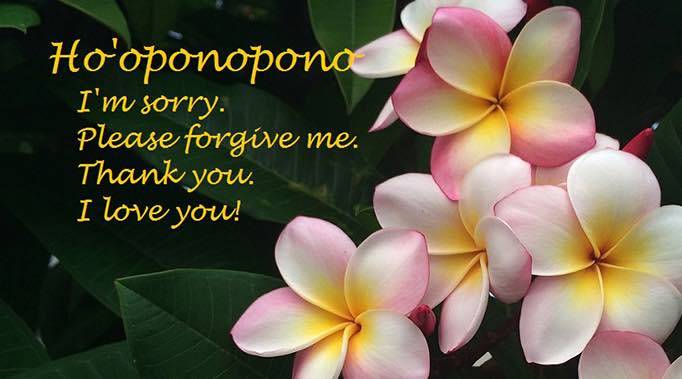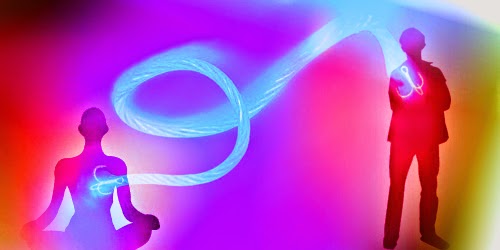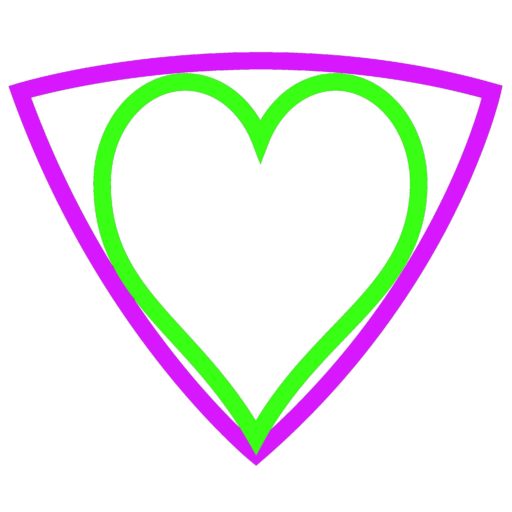The Ho ‘oponopono – a Simple and Effective Healing Tool

The Ho ‘oponopono is a two part process that helps with forgiveness and reconciliation (cuts toxic energy cords between you and other people). It comes from the Hawaiian tradition, but has spread all over the world because of its effectiveness.
It’s a very simple process that takes about 5 minutes:
- Choose someone that you have tension with (can be anger, a grudge, any toxic energy).
- Close your eyes and visualize there is a white cloud of energy that enters your head through your Crown chakra and goes all the way down through your body and exits the souls of your feet and goes to Mother Earth. Do this process 3x.
- Visualize there is a small stage in front you and behind the stage there is a white mist of light/energy. Call the soul of this person and say “(Name), please join me”. See this person coming from the back of the stage and walking until they stand up before you on the stage. Perform the same process in Step #2 to this person and do it 3x.
- Now look into the eyes of this person and say, “I’m sorry, please forgive me, I forgive you, thank you” and if you can say, “I love you” – Do this 3x.
- Visualize there is a cord of energy attached between the both of you and there is a sword made of light. Grab the sword with love and cut the energy cord. See the cord dissolve until nothing is between both of you.
- Then tell this person, “Thank you for joining me, you are released” and watch this person turn away and walk to the back of the stage towards the light until he/she disappears.
 We have this physical body and our soul, which is part of us and is energy. This energy is in contact with everyone else in the whole universe. So if we don’t forgive someone, we’re not forgiving a part of ourselves because we are all one. We all need to forgive and ask for forgiveness and when we do, we are free and you will feel it.
We have this physical body and our soul, which is part of us and is energy. This energy is in contact with everyone else in the whole universe. So if we don’t forgive someone, we’re not forgiving a part of ourselves because we are all one. We all need to forgive and ask for forgiveness and when we do, we are free and you will feel it.
I learned Ho’oponopono straight from the source, the Kahunas, Hawaiian Energy Healers, from Dr. Matt James, who lives in Hawaii.in an NLP training.
Here is an article from Psychology Today, by Dr. Matt James about a scientific study on the use of Ho’oponopono:
The Hawaiian Secret of Forgiveness,
by Dr. Matt James
Ho‘oponopono can help anyone let go of resentment
When it comes to learning to forgive others, it turns out we can learn a lot from ancient indigenous people such as those who inhabited Hawai’i before the coming of westerners. They understood on a gut level that to harbor resentment against others hurts the person who refuses to forgive.
As I’ve explained in recent posts, ho‘oponopono, the Hawaiian forgiveness process, allows us to cut the aka connection (essentially clearing out preconceptions in how we view others) to create new connections and rejuvenated relationships. In Huna, the ancient Hawaiian discipline of energy and healing, the ho‘oponopono process is essential if we want to be pono (right and congruent with ourselves). This makes sense. After all, how can anyone feel good about themselves and their own life when they walk around stewing over how they been wronged?
The Hawaiian word ho‘oponopono comes from ho‘o (“to make”) and pono (“right”). The repetition of the word pono means “doubly right” or being right with both self and others. In a nutshell, ho‘oponopono is a process by which we can forgive others to whom we are connected.
Practicing Ho‘oponopono allows you to cut the aka connection in a very positive, loving way, knowing that you can make the connection brand new. When you become right with others, you become right with yourself. My own research has validated this approach.
Over the years, people have said to me: “Ho‘oponopono sounds great, but where is the proof that it works?” So when I went back to school to pursue my Ph.D., I picked ho‘oponopono as my research focus. I wanted to verify how it works because Ho‘oponopono is more than just a concept that I teach. It is a part of my family lineage and how I live my life.
I gave a lecture to a Hawaiian studies group at the University of Hawaii about my Huna lineage and about ho‘oponopono. I started the talk by describing my lineage and my particular kumu (teachers). At the very end, I mentioned I had researched ho‘oponopono for my doctoral degree. I intentionally shared in this particular order because, though Western thinking focuses on proof and statistics, in the ancient culture, lineage and practice were more important. The fact that my research validated the process was simply “icing on the cake” as one of the professors said.
Within the state of Hawai’i, we have four counties, each having city and county governments. The reason for breaking Hawai’i into four counties dates back hundreds of years when there were four kingdoms, the kingdoms of Hawai’i, Maui, O‘ahu. and Kauai. There are smaller island kingdoms as well, but the four big ones were the most prominent.
If the kings of these kingdoms didn’t happen to like each other, there would be no communication between the islands for hundreds of years. So even though the islands were close together geographically, each island’s culture grew in a slightly different direction. In fact, when the missionaries arrived early in the nineteenth century, the Hawaiian language sounded to them as though there were four different dialects.
This helps explain why the process of ho‘oponopono is practiced differently on the different islands. As described by Victoria Shook (1992), ho‘oponopono was conducted face to face in many families. On some islands, if you have someone with whom you aren’t pono, you ask another person to facilitate a meeting between the two of you, usually someone in the family. The facilitator allows each person time to express themselves, to get whatever the issue is off their chests, let it go, and then move forward together – to become pono.
At the other end of the spectrum, ho‘oponopono can be a process you experience individually, within your mind only. You disconnect then reconnect, if you choose to do so, internally.
There are a variety of methods of ho‘oponopono between these two variations, but the approach from my lineage that I share in my trainings occurs within the mind. The research I conducted validated the ho‘oponopono process itself and how individuals benefit by doing the process within their own in their minds.
My study included a test group (a group who experienced ho‘oponopono) and a control group (the group who did not experience the process). The research measured unforgiveness (defined in psychology as motivations for revenge and avoidance).
Participants were surveyed on their feelings before using the process, immediately after, and two weeks later, then their answers were compared with those of the control group. Simply put, the research showed that the group who practiced ho‘oponopono experienced a statistically significant reduction in unforgiveness compared to the group who did not.
While my study focused on people practicing ho‘oponopono once, it is important to remember that this is an ongoing process, not something you do just once. I’ll be sharing more of the “how to” in posts to come.
Aloha!
——————————————-
Matthew B. James, MA, Ph.D., is President of Kona University and its training and seminar division The Empowerment Partnership, where he serves as a master trainer of Neuro Linguistic Programming (NLP), a practical behavioral technology for helping people achieve their desired results in life. His new book, The Foundation of Huna: Ancient Wisdom for Modern Times, details forgiveness and meditation techniques used in Hawaii for hundreds of years. He carries on the lineage of one of the last practicing kahuna of mental health and wellbeing. To reach Dr. James, please e-mail him at info@Huna.com
